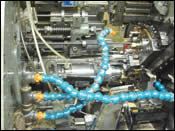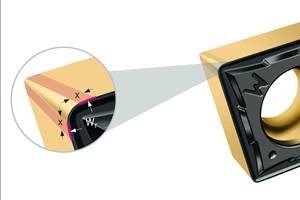The Case For Quick Change On Multi-Spindles
Even in the world of long-running, high-volume production on cam-driven automatics, quick-change tooling makes sense.
Share





Cam-driven, multi-spindle automatic machines are still the epitome of efficient, high-volume production equipment for small precision turned parts. When it comes to spitting out parts in quantities in the thousands or even millions, Davenports, Brown & Sharpes, New Britains, Acmes and other cam-driven machines excel in terms of parts-per-hour or other measures of cycle time.
However, the changing manufacturing landscape in the United States—JIT and smaller batches—makes it challenging to use equipment originally designed for high-volume jobs. Faster setups are crucial to increasing a machine’s flexibility. Traditional multi-spindles are difficult to change-over and setup, requiring a high level of skill that is becoming increasingly scarce. The setup time for some multi-spindle machines, for example, can take the better part of a day, while replacing worn tools can also be time-consuming and complex.
Shops that rely on cam-driven automatics have to confront these issues to let these machines keep their place as competitive production assets. Aside from investing in expensive capital equipment, how can high-production shops maximize machine uptime while minimizing operational costs?
“One option for increasing the flexibility of such production machines is quick-change tooling,” says Jerry Somma, vice president of sales at Somma Tool Co. Inc. (Waterbury, Connecticut). “Strategically, this tooling can enhance the productivity of cam-driven equipment, in turn giving it a new lease on life for high-volume production.”
His company offers tooling for screw machines, turret lathes and CNC lathes, including preset and quick-change tooling, cutting tools, toolholders, workholding and accessories.
Said to be as rigid as conventional tooling, the quick-change alternative can expedite setups; lessen insert changeovers to 1 minute; eliminate the need for dial indicating or gages, because the centerline and lateral position never change; and reduce tooling expenditures because the resharpenable inserts can be used 20 to 30 times.
Why Quick Change?
The conventional method of changing tools on a multi-spindle automatic involves removing both the toolholder and the worn insert to resharpen the insert. Once the worn insert has been resharpened, the operator puts everything back together. The operator would then typically use a dial indicator or some other gage to relocate the center. Quick-change tooling eliminates this last step, greatly reducing changeover time.
The Dish On Datum Point
Quick-change systems can incorporate “datum point” technology. A common toolholder uses different tools that can be interchanged without the need to move the holder or set each tool. The center height and the lateral position are maintained when the insert is changed.
This concept is applied to Somma’s Resharpenable Quick Change (RQC) insert-type form toolholders, with which a family of similar parts can be produced by only changing the form tool. Once the proper center height and lateral location for the job have been established, the holder never has to be moved. There is no need to adjust to centerline, as the design of the holder ensures that the lateral positioning of the form tool doesn’t change. Each time the user places the insert in the holder, it is brought right back to center.
Somma offers two insert form tool systems—a resharpenable model and a throw-away style model. Both facilitate swift changeovers, and both models have the capability to return to center because both can be used with the same quick-change toolholder. In particular, the resharpenable variety can be advantageous for contract shops dealing with repeat orders.
Because the toolholders and inserts are compatible with many machine models, the same formed insert can be swapped between various machines to standardize tooling on the shop floor. When one insert becomes dull from machining, the operator can pull that insert out and put in the second. With the turn of an Allen wrench, the insert moves into position, at which point operation can resume. This change-over is said to require an average of less than 1 minute.
Measures To Modernize
Cox Manufacturing Company illustrates how quick-change tooling can be integrated as part of a shop’s successful modernization strategy. For the San Antonio, Texas, shop, phasing over to quick change was part of a larger plan to boost productivity on the shop floor. Not only did the screw machine shop slash tool changing times, but it also developed a homegrown system to determine the optimum time to change tools.
The company was founded in 1956 with one Swiss-type automatic. Today, a fair amount of its business relies on the output of its Davenport and Acme multi-spindles. In response to the influx of high-volume orders, Cox has also expanded its capabilities to encompass technologies such as camless bar automatics and CNC machines.
“When production volume requirements run in the hundreds of thousands or even millions, multi-spindles are particularly effective,” says Bill Cox, owner.
To continue to take advantage of the productivity of these multi-spindles in the pursuit of higher-value parts, Cox realized that it would need to modernize the machines just enough to allow a small number of machinists to oversee them. One possible avenue was implementing quick-change tooling. Mr. Cox says the quick-change method eliminates the complexities of older-style circular form tools that required substantial skill and training for a technician to fully understand and set up properly. Because the datum-point concept can be applied to various machines, Cox could use the tooling on both its Davenport and its Acme machines.
The shop test-drove Somma’s quick-change tool posts with side-adjusting clamp for its Davenports. Following that trial run years ago, the company purchased eight different toolholders from Somma and has been purchasing quick-change toolholders ever since.
Aside from the switch to quick change, Cox identified another tool to aid in streamlining its operations. Starting with a programmable logic controller (PLC) from Omron Electronics, Inc. (Schaumburg, Illinois), Mr. Cox created a user interface solely for use with his Davenport machines. The system was implemented during 1998 to 2000, with the shop’s engineering staff writing the program. Formerly, Cox relied on operator expertise to determine the right moment to change tools, which proved to be problematic given the dwindling pool of seasoned machinists.
“The PLC system on the Davenports monitors for broken tools, short feeds, tool life, schedules, cycle time, low lube levels and coolant flow,” says Mr. Cox. “Anticipating tool wear trends and the appropriate times at which to execute tool changes is no longer a concern.” By determining just when to make a quick change, the tool monitoring further increases staff productivity.
Related Content
Sandvik Coromant Grooving Tool Provides Stable Performance
The CoroCut 2 system features an improved clamping finger design, which offers a higher clamping force and better side stability.
Read MoreWalter Turning Grades Feature Curved Wiper Cutting Edge
The FW4 and MW4 positive wiper geometries provide a wiper action that can reportedly be used to reduce machining time by using double the feed rate.
Read MoreKyocera Turning Grade Provides Tough Cutting Edge
The Megacoat Tough coating combines a wear-resistant layer on the surface adhered to high-content CBN, which provides greater fracture resistance when encountering interruptions.
Read MoreSandvik Coromant Parting Tool Provides Improved Surface Quality
CoroCut QD Y-axis parting tools feature upgraded blades with no Y offset, providing easier programming and increased stroke.
Read MoreRead Next
Setting Up the Building Blocks for a Digital Factory
Woodward Inc. spent over a year developing an API to connect machines to its digital factory. Caron Engineering’s MiConnect has cut most of this process while also granting the shop greater access to machine information.
Read MoreBuilding Out a Foundation for Student Machinists
Autodesk and Haas have teamed up to produce an introductory course for students that covers the basics of CAD, CAM and CNC while providing them with a portfolio part.
Read More5 Rules of Thumb for Buying CNC Machine Tools
Use these tips to carefully plan your machine tool purchases and to avoid regretting your decision later.
Read More.png;maxWidth=970;quality=90)































